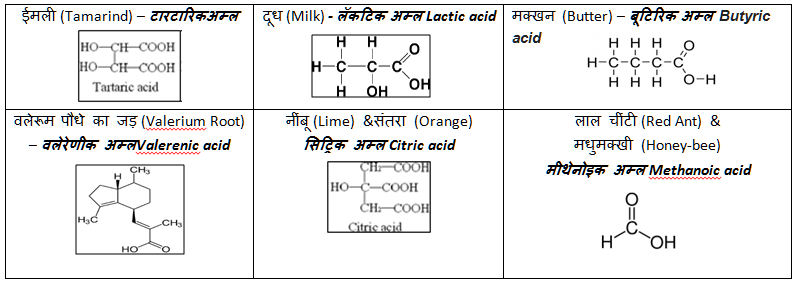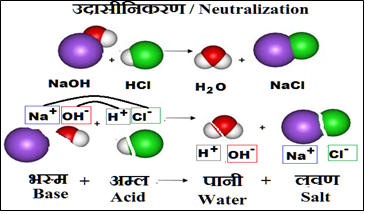इस लेखन मे 10 वी कक्षा का 3rd अध्याय ‘अम्ल भस्म का रसायन’ के स्वाध्याय के उत्तर लिखे गये हैं. संधर्भ के लिए पाठ पुस्तक का भी उपयोग करें.
In this post for 10th standard students, 3rd chapter titled ‘Magic of chemical reactions’ is being covered. Please use the text book for reference.
वीडियो लेक्चर से सीखें Learn from video lectures:
Part 1: https://www.youtube.com/watch?v=ej_8DABEVMQ
Part 2: https://www.youtube.com/watch?v=wqRdMeKYX9c
Part 3: https://www.youtube.com/watch?v=Q2WvkHRCiSU
एक बार खुद से प्रश्नों के उत्तर लिखने की कोशिश करें. उसके बाद उत्तर के लिए नीचे स्क्रोल करें.
Please try answering the questions below by yourself first, then scroll down for the answers.
_____________________________________________________________________________________________________________
प्रश्न Questions
_____________________________________________________________________________________________________________
प्र १) रिक्त स्थानों की पूर्ति करो
१. बहुत से अम्लीय पधार्तों का स्वाद ___________ होता है.(Many acidic substances have ____________ taste.)
२. फिनप्थलीन ____________ प्रकार का सूचक है. (Phenolphthalein is a __________ kind of indicator.)
३. भास्मिक पधार्तों की शक्ति को _________ द्वारा प्रदर्शित करते हैं.
Strength of basic substances is shown in ________ scale.
४. pHमापक की सीमा ___________ से __________ के बीच होती है.
pH scale is measured between ________ and __________.
५. अम्ल और भस्म एक दूसरे को उदासीन कर __________ और _________ बनाते हैं.
- Acid and base neutralize each other to become _________ and ___________.
६. सोडियम या पोटाशियम लवन के उच्च वसीय अम्ल को ________ कहते हैं.
Sodium and potassium salt of carboxylic acid is known as ______________.
७. FeSO4.7 H2O में H2O ____________ प्रदर्शित करता है. In FeSO4.7H2O, H2O is _____________________.
८. 10 % NaClको ___________ कहते हैं. 10% NaCl is known as __________.
प्र २) नीचे लिखे गये पधर्तों मे कौँसे अम्ल हैं बताइए (Tell which acid is found in the list given below)
ईमली (Tamarind), मक्खन (Butter), वलेरूम पौधे का जड़ (Valerium Root), नींबू (Lime), दूध (Milk), संतरा (Orange), लाल चींटी (Red Ant), मधुमक्खी (Honey-bee)
प्र ३) संक्षेप में टिप्पणी लिखो ( Write short answers)
१. सूचक (योग्य उदाहरण के साथ) (Indicator, with example)
२. pHमापक (आकृति के साथ) (pH scale, with diagram)
३. केलासन जल (योग्य उदाहरण द्वारा) (Water of crystallization)
प्र ४ निम्नलिखित के उत्तर लिखिए. (Write answers to the following)
१. धातुकर्बोनटेस अम्ल के साथ कैसे क्रिया करता है ? How metal carbonates react with acids?
२. हाइड्रोनियम आयन (Hydronium) को उदाहरण द्वारा स्पष्ट कीजिए. Explain Hydronium ion with example.
३. वैसविक सूचक से क्या समझते ही ? सोडियम हाइडरॉक्साइड की Mg(OH)2 से क्रिया होती है यदि नही तो क्यों ?
What do you understand by universal indicator? Will sodium hydroxide react with magnesium hydroxide? Why or why not?
४. खाने के सोडे का उपयोग बताइए. What are the uses of baking soda?
प्र ५ अम्लों और भास्मों की परस्पर कैसी अभिक्रिया होती है ? हम क्रिया का नाम क्या है ? इस प्रतिक्रिया के फलस्वरूप उत्पाद क्या प्राप्त होता है? What happens in a reaction between acid and base? What is the name of the reaction? What are the products of such reaction?
_____________________________________________________________________________________________________________
उत्तर Answers
_____________________________________________________________________________________________________________
१. बहुत से अम्लीय पधार्तों का स्वाद खट्टा होता है. Many acidic substances have sour taste.
२. फिनप्थलीन संश्लेषित प्रकार का सूचक है. Phenolphthalein is a synthetic kind of indicator.
३. भास्मिक पधार्तों की शक्ति को pOH द्वारा प्रदर्शित करते हैं. Strength of basic substances is shown in pOH scale.
४. pH मापक की सीमा 0 से 14 के बीच होती है.pH scale is measured between 0 and 14.
५. अम्ल और भस्म एक दूसरे को उदासीन कर लवण और पानी बनाते हैं. Acid and base neutralize each other to become salt and water.
६. सोडियम या पोटाशियम लवन के उच्च वसीय अम्ल को सबून कहते हैं. Sodium and potassium salt of carboxylic acid is known as soap.

(http://www.ebotaniq.com.au/images/eBotaniqPics/product/product%20pictures/molecules/triglyceride.jpg)
७. FeSO4.7H2O में H2O केलासन जल प्रदर्शित करता है. In FeSO4.7H2O, H2O is water of crystallization.
८. 10 % NaCl को ब्राइन कहते हैं. 10% NaCl is known as brine.
प्र २) नीचे लिखे गये पधर्तों मे कौँसे अम्ल हैं बताइए (Tell which acid is found in the list given below)

प्र ३) संक्षेप में टिप्पणी लिखो ( Write short answers)
१. सूचक (Indicator): कुछ संश्लेषित और रसायनिक पदार्थों के द्वारा यौगिक के अम्लीय और भास्मिक गुण को प्रदर्शित करते हैं, इन्हे सूचक कहते हैं. उदाहरण लिटमस पेपर मे लैकेन-सुकायोद भिद नामक पौधे से प्राप्त हुआ योगिक अम्ल मे नीले से लाल और भस्म मे लाल से नीला हो जाता है. प्राकृतिक पधर्थ जैसे लाल गुलाब, हल्दी & चुकंदर भी अम्ल-भस्म का सूचक के रूप मे उपयोग होता है.
Some chemical and synthetic compounds can differentiate between an acidic and basic solution, they are known as indicators. For example, Litmus paper containing compound from Thyllophyta changes color from blue to red in acid and red to blue in base. Natural compounds in red rose, turmeric & beetroot can also be pH indicators.
Turmeric is a versatile indicator, can be used for artistic expressions too!
२. pHमापक (pH scale): pH याने पोटेन्ज़ स्केल मापक के सहायाता से विलयान के हाइड्रोजन आयनो (H+) की सान्द्र्ता को माप सकते हैं. यह मापक ० से १४ तक होता है, ० से ७ के बीच अम्ल होते हैं और ७ से १४ के बीच भस्म. pH 0 तीव्र अम्ल है और उसके pH 7 तक अम्ल कमज़ोर होता जाता है यानी H+ देने की क्षमता कम होती जाती है. pH 14 के पास तीव्र भस्म है, और जैसे हम pH 7 की ओर कम करते आते हैं, भस्म के तीव्रता भी कम होती जाती है, यानी उसकी OH- देने की क्षमता कम होती जाती है. शुद्ध पानी का pH 7 होता है, यानी वो उदासीन है.
pH or potenz scale is used to measure the strength of H+or its concentration in the solution. pH scale ranges from 0 to 14, 0 to 7 are acids & 7 to 14 are bases. pH 0 acids are strong acids, and as we increase towards pH7 their strength decreases, i.e. their ability to release H+ ions decreases. pH14 are strong bases, and as we decrease pH to 7 their strength decrease, i.e. their ability to release OH- ions decreases. Water is neutral at pH 7.
३. केलासन जल (Water of crystallization):केलासन जल उस जल के उन अणुओं को कहते हैं जो किसी लवन के साथ एक स्थिर अनुपात मे जुड़कर उसके क्रिस्टल की संरचना मे आंतरिक रूप से भाग लेता है. उदाहरण निर्जल कॉपर सलफेट मे पानी डालने पर नीले रंग का सजल कॉपर सलफेट की रचना होती है, जिसका सूत्र CuSO4.5H2O है, यानी हर CuSO4लवण के साथ 5H2O जुड़ता है.
Water of crystallization refers to those molecules of water which bonds with the salt crystal. They bond in fixed ratio to the salt crystal and form an essential part within the crystal structure. For example, on anhydrous copper sulfate CuSO4, when water is added, it becomes blue coloured hydrated copper sulfate, CuSO4.5H2O, i.e. 5 molecules of H2O gets attached to one molecule of CuSO4 to make the crystal.

प्र ४ निम्नलिखित के उत्तर लिखिए. (Write answers to the following)
१. धातुकर्बोनटेस अम्ल के साथ कैसे क्रिया करता है ? How metal carbonates react with acids?
धातु कारबनेट जब अम्ल से अभिक्रिया करती है तब लवण, पानी और साथ मे कार्बन डाइयाक्साइड गैस भी उत्पन्न होता है.
Na2CO3 + 2HCl –> 2NaCl + H2O + CO2 (g)
Metal carbonates react with acids to form salt, H2O and CO2 gas is also liberated.
Na2CO3 + 2HCl –> 2NaCl + H2O + CO2 (g)
२. हाइड्रोनियम आयन (Hydronium) को उदाहरण द्वारा स्पष्ट कीजिए. Explain Hydronium ion with example.
उदासीन पानी मे या अम्ल मे जब प्रोटॉन (H+) का पानी से बंधन होता है, तब हाइड्रोनीयम घनायन (H3O+) बनता है.
2 H2O –> H3O+ + OH– & HCl + H2O –> H3O+ + Cl–
In neutral water or in acid, when proton (H+)break and binds with water, hydronium cation (H3O+) is formed.
2 H2O –> H3O+ + OH– & HCl + H2O –> H3O+ + Cl–
३. वैसविक सूचक से क्या समझते ही ? सोडियम हाइडरॉक्साइड की Mg(OH)2 से क्रिया होती है यदि नही तो क्यों ?
What do you understand by universal indicator? Will sodium hydroxide react with magnesium hydroxide? Why or why not?
वैश्विक सूचक कई विभिन्न pH सूचकों का मिश्रण है जो अम्ल से भस्म के पूरे श्रेणी मे, याने pH 1 से 14 तक, क्रमिक रूप से रंग मे परिवर्तन दर्शाता है, जिससे हम किसी भी विलयन के अम्लीय या भास्मिक गुण का अनुमान लगा सकते हैं.
A universal indicator is a pH indicator composed of a solution of several compounds that exhibits several smooth colour changes over a pH value range from 1 to 14 to indicate the acidity or alkalinity of solutions.
४. खाने के सोडे का उपयोग बताइए. What are the uses of baking soda?
बेकिंग सोडा के कई उपयोग हैं:
१) डोसा, ढोकला, केक आदि को हल्का और छिद्रयुक्त बनाने के लिए.
२) पेट की अम्लीयता कम करने के लिए.
३) CO2 छोड़ने के वजह से आग भुजाने के लिए.
४) और कई प्राकृतिक औषध जैसे हल्दी के साथ त्वचा / केश को सॉफ और स्वस्थ रखने के लिए.
Baking soda is used for:
1) Making dough for cake, dhokla, dosas fluffy and porous.
2) Since it is a base, it can be taken to neutralize stomach acidity.
3) To extinguish fire as it generates CO2.
4) It can also be used with other natural substances like turmeric for skin and hair cleaning.
प्र ५ अम्लों और भास्मों की परस्पर कैसी अभिक्रिया होती है ? हम क्रिया का नाम क्या है ? इस प्रतिक्रिया के फलस्वरूप उत्पाद क्या प्राप्त होता है? What happens in a reaction between acid and base? What is the name of the reaction? What are the products of such reaction?
अम्ल और भस्म एक दूसरे को उदासीन कर लवण और पानी बनाते हैं. इस अभिक्रिया को उदासीनिकरण कहते हैं.
NaOH + HCl –> NaCl + H2O
Acid and base neutralize each other to become salt and water. The reaction is known as neutralization.
NaOH + HCl –> NaCl + H2O

_____________________________________________________________________________________________________________
कोई संदेह या सवाल के लिए मैल करें (For doubts or questions mail to) : nikhilesh@asanvigyan.in
